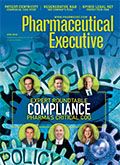- Sustainability
- DE&I
- Pandemic
- Finance
- Legal
- Technology
- Regulatory
- Global
- Pricing
- Strategy
- R&D/Clinical Trials
- Opinion
- Executive Roundtable
- Sales & Marketing
- Executive Profiles
- Leadership
- Market Access
- Patient Engagement
- Supply Chain
- Industry Trends
A Seat at the Strategy Table
Pharmaceutical Executive
How navigating compliance risks requires so much more than policies and procedures.
CBI’s Pharmaceutical Compliance Congress recently convened a diverse and insightful panel to reflect on the state of the compliance role within the pharmaceutical industry. There were several key messages-all invariably leading back to the challenges and opportunities of securing an effective place at a drug corporation’s executive table.
Unlike the dog who one day catches the car, this goal is not about the chase. The prize here is of utmost importance: the opportunity to build and maintain company value and reputation with key stakeholders, including patients, investors, regulators, and employees; no small task and no small reward.
This is, in essence, a corporation’s business case for quality-which compliance is a part of. Quality has been defined by many in different ways. Often times when someone says “quality,” others think “compliance.” But there is a difference.
As pioneers of quality management, Joseph Juran defined quality as “fitness for use;” Philip Crosby referred to it as “conformance to requirements;” and W. Edwards Deming essentially said that cost goes down and productivity goes up when quality goes up. In total, quality resonates as something that involves people, processes, performance, and expectations-including those of key stakeholders-and, hence, is much broader and more strategic than compliance.
There’s no doubt that clear and relevant policies and procedures are necessary in navigating compliance risks. But that’s only the starting point. All large multinational and most smaller organizations have world-class systems in place.
Yet, compliance issues still arise, some even resulting in consent decrees or corporate integrity agreements, damaging company value and reputation sometimes beyond repair. Why? Navigating compliance risks requires so much more than policies, procedures, and even a seat at the executive table.
Let’s build on the recent panel discussion with the following quality-related strategies:
• Quality and compliance are not spectator sports. Having someone with a seat at the big table is a ticket to the game. But more than a seat is required for effectiveness. Direction, ownership, and accountability all start at the top of the organization. But for a company to be successful in navigating compliance risks, everyone-not just the compliance officer or department-must have a role with clear responsibilities and expectations.
• Anticipating, identifying, and resolving potential issues. How well do you understand your risks and how well are you taking proactive measures to prioritize and mitigate those risks (e.g., working cross-functionally to break through silos) to fully integrate with your business plan? Having the right people with the right expertise and foresight involved in early and ongoing risk assessments is essential.
• Building mutual trust and respect – Secret Sauce #1.Unexpected issues will always arise. But that’s not the time for building relationships. For those messy situations, it is paramount to have transparent and collaborative working relationships already ingrained internally with third parties and with key stakeholders so that conflicts can be raised and resolved quickly and effectively to minimize potential damage to value and reputation.
• What and when to invest – Secret Sauce #2.Every organization faces the same challenge of limited resources and even less time. As such, compliance needs often are put on hold. So, with everyone vying for a piece of the same budget, it becomes critical that quality/compliance is able to effectively justify what and when to invest in the context of the overall business plan. Being able to project the return on that investment almost always beats the costs of non-conformances.
• Alignment of rewards, recognition, selection, and promotion. Culture can be defined as what’s done and not done, what’s said and not said, and the resulting consequences. So, in considering the role of corporate culture in navigating compliance risks, remember that what gets rewarded gets done.
Regulations and legal interpretations are always evolving in the fast-paced world of innovative life sciences. Navigating compliance risks requires so much more than policies and procedures. For the large pharma player or the startup, it involves all of the strategies mentioned and more to get out in front of potential issues before they become significant pain points-thereby creating a competitive advantage for the business and more predictability and confidence for the key stakeholders.

Kevin J. Slatkavitz is President and Founder of ThinkQuality, LLC. He can be reached at kevinslatkavitz@thinkqualityllc.com

To Tackle the Plastic Waste Crisis in Pharma, Here’s Where to Start
October 30th 2024By demonstrating big advancements in recycling, pharma companies will be much more likely to attract shareholders and other investors, giving themselves a leg up in the competition to lead the biopharmaceutical industry well into the future.
